Scientists’ Comments on the Scientific
Miracles in the Holy Quran
The following are some comments of scientists1 on the scientific miracles in the Holy Quran. All of these comments have been taken from the videotape entitled This is the Truth. |
1) Dr. T. V. N. Persaud is Professor of Anatomy, Professor of Pediatrics and Child Health, and Professor of Obstetrics, Gynecology, and Reproductive Sciences at the University of Manitoba, Winnipeg, Manitoba, Canada. There, he was the Chairman of the Department of Anatomy for 16 years. He is well-known in his field. He is the author or editor of 22 textbooks and has published over 181 scientific papers. In 1991, he received the most distinguished award presented in the field of anatomy in Canada, the J.C.B. Grant Award from the Canadian Association of Anatomists. When he was asked about the scientific miracles in the Quran which he has researched, he stated the following:
“The way it was explained to me is that Muhammad was a very ordinary man. He could not read, didn’t know [how] to write. In fact, he was an illiterate. And we’re talking about twelve [actually about fourteen] hundred years ago. You have someone illiterate making profound pronouncements and statements and that are amazingly accurate about scientific nature. And I personally can’t see how this could be a mere chance. There are too many accuracies and, like Dr. Moore, I have no difficulty in my mind that this is a divine inspiration or revelation which led him to these statements.” (View the RealPlayer video of this comment  )
)
Professor Persaud has included some Quranic verses and sayings of the Prophet Muhammad  in some of his books. He has also presented these verses and sayings of the Prophet Muhammad
in some of his books. He has also presented these verses and sayings of the Prophet Muhammad  at several conferences.
at several conferences.
2) Dr. Joe Leigh Simpson is the Chairman of the Department of Obstetrics and Gynecology, Professor of Obstetrics and Gynecology, and Professor of Molecular and Human Genetics at the Baylor College of Medicine, Houston, Texas, USA. Formerly, he was Professor of Ob-Gyn and the Chairman of the Department of Ob-Gyn at the University of Tennessee, Memphis, Tennessee, USA. He was also the President of the American Fertility Society. He has received many awards, including the Association of Professors of Obstetrics and Gynecology Public Recognition Award in 1992. Professor Simpson studied the following two sayings of the Prophet Muhammad  :
:
{In every one of you, all components of your creation are collected together in your mother’s womb by forty days...}2
{If forty-two nights have passed over the embryo, God sends an angel to it, who shapes it and creates its hearing, vision, skin, flesh, and bones....}3
He studied these two sayings of the Prophet Muhammad  extensively, noting that the first forty days constitute a clearly distinguishable stage of embryo-genesis. He was particularly impressed by the absolute precision and accuracy of those sayings of the Prophet Muhammad
extensively, noting that the first forty days constitute a clearly distinguishable stage of embryo-genesis. He was particularly impressed by the absolute precision and accuracy of those sayings of the Prophet Muhammad  . Then, during one conference, he gave the following opinion:
. Then, during one conference, he gave the following opinion:
“So that the two hadeeths (the sayings of the Prophet Muhammad  ) that have been noted provide us with a specific time table for the main embryological development before forty days. Again, the point has been made, I think, repeatedly by other speakers this morning: these hadeethscould not have been obtained on the basis of the scientific knowledge that was available [at] the time of their writing . . . . It follows, I think, that not only there is no conflict between genetics and religion but, in fact, religion can guide science by adding revelation to some of the traditional scientific approaches, that there exist statements in the Quran shown centuries later to be valid, which support knowledge in the Quran having been derived from God.” (View the RealPlayer video of this comment
) that have been noted provide us with a specific time table for the main embryological development before forty days. Again, the point has been made, I think, repeatedly by other speakers this morning: these hadeethscould not have been obtained on the basis of the scientific knowledge that was available [at] the time of their writing . . . . It follows, I think, that not only there is no conflict between genetics and religion but, in fact, religion can guide science by adding revelation to some of the traditional scientific approaches, that there exist statements in the Quran shown centuries later to be valid, which support knowledge in the Quran having been derived from God.” (View the RealPlayer video of this comment  )
)
3) Dr. E. Marshall Johnson is Professor Emeritus of Anatomy and Developmental Biology at Thomas Jefferson University, Philadelphia, Pennsylvania, USA. There, for 22 years he was Professor of Anatomy, the Chairman of the Department of Anatomy, and the Director of the Daniel Baugh Institute. He was also the President of the Teratology Society. He has authored more than 200 publications. In 1981, during the Seventh Medical Conference in Dammam, Saudi Arabia, Professor Johnson said in the presentation of his research paper:
“Summary: The Quran describes not only the development of external form, but emphasizes also the internal stages, the stages inside the embryo, of its creation and development, emphasizing major events recognized by contemporary science.” (View the RealPlayer video of this comment  )
)
Also he said: “As a scientist, I can only deal with things which I can specifically see. I can understand embryology and developmental biology. I can understand the words that are translated to me from the Quran. As I gave the example before, if I were to transpose myself into that era, knowing what I knew today and describing things, I could not describe the things which were described. I see no evidence for the fact to refute the concept that this individual, Muhammad, had to be developing this information from some place. So I see nothing here in conflict with the concept that divine intervention was involved in what he was able to write.”4 (View the RealPlayer video of this comment  )
)
4) Dr. William W. Hay is a well-known marine scientist. He is Professor of Geological Sciences at the University of Colorado, Boulder, Colorado, USA. He was formerly the Dean of the Rosenstiel School of Marine and Atmospheric Science at the University of Miami, Miami, Florida, USA. After a discussion with Professor Hay about the Quran’s mention of recently discovered facts on seas, he said:
“I find it very interesting that this sort of information is in the ancient scriptures of the Holy Quran, and I have no way of knowing where they would come from, but I think it is extremely interesting that they are there and that this work is going on to discover it, the meaning of some of the passages.” And when he was asked about the source of the Quran, he replied: “Well, I would think it must be the divine being.” (View the RealPlayer video of this comment
 )
)
5) Dr. Gerald C. Goeringer is Course Director and Associate Professor of Medical Embryology at the Department of Cell Biology, School of Medicine, Georgetown University, Washington, DC, USA. During the Eighth Saudi Medical Conference in Riyadh, Saudi Arabia, Professor Goeringer stated the following in the presentation of his research paper:
“In a relatively few aayahs (Quranic verses) is contained a rather comprehensive description of human development from the time of commingling of the gametes through organogenesis. No such distinct and complete record of human development, such as classification, terminology, and description, existed previously. In most, if not all, instances, this description antedates by many centuries the recording of the various stages of human embryonic and fetal development recorded in the traditional scientific literature.” (View the RealPlayer video of this comment  )
)
6) Dr. Yoshihide Kozai is Professor Emeritus at Tokyo University, Hongo, Tokyo, Japan, and was the Director of the National Astronomical Observatory, Mitaka, Tokyo, Japan. He said:
“I am very much impressed by finding true astronomical facts in [the] Quran, and for us the modern astronomers have been studying very small pieces of the universe. We’ve concentrated our efforts for understanding of [a] very small part. Because by using telescopes, we can see only very few parts [of] the sky without thinking [about the] whole universe. So, by reading [the] Quran and by answering to the questions, I think I can find my future way for investigation of the universe.” (View the RealPlayer video of this comment  )
)
7) Professor Tejatat Tejasen is the Chairman of the Department of Anatomy at Chiang Mai University, Chiang Mai, Thailand. Previously, he was the Dean of the Faculty of Medicine at the same university. During the Eighth Saudi Medical Conference in Riyadh, Saudi Arabia, Professor Tejasen stood up and said:
“During the last three years, I became interested in the Quran . . . . From my study and what I have learned from this conference, I believe that everything that has been recorded in the Quran fourteen hundred years ago must be the truth, that can be proved by the scientific means. Since the Prophet Muhammad could neither read nor write, Muhammad must be a messenger who relayed this truth, which was revealed to him as an enlightenment by the one who is eligible [as the] creator. This creator must be God. Therefore, I think this is the time to say La ilaha illa Allah, there is no god to worship except Allah (God),Muhammadur rasoolu Allah, Muhammad is Messenger (Prophet) of Allah (God). Lastly, I must congratulate for the excellent and highly successful arrangement for this conference . . . . I have gained not only from the scientific point of view and religious point of view but also the great chance of meeting many well-known scientists and making many new friends among the participants. The most precious thing of all that I have gained by coming to this place is La ilaha illa Allah, Muhammadur rasoolu Allah, and to have become a Muslim.” (View the RealPlayer video of this comment  )
)
After all these examples we have seen about the scientific miracles in the Holy Quran and all these scientists’ comments on this, let us ask ourselves these questions:
n Could it be a coincidence that all this recently discovered scientific information from different fields was mentioned in the Quran, which was revealed fourteen centuries ago?
n Could this Quran have been authored by Muhammad  or by any other human being?
or by any other human being?
The only possible answer is that this Quran must be the literal word of God, revealed by Him.
The Quran on Clouds
Scientists have studied cloud types and have realized that rain clouds are formed and shaped according to definite systems and certain steps connected with certain types of wind and clouds. |
One kind of rain cloud is the cumulonimbus cloud. Meteorologists have studied how cumulonimbus clouds are formed and how they produce rain, hail, and lightning.
They have found that cumulonimbus clouds go through the following steps to produce rain:
1) The clouds are pushed by the wind:Cumulonimbus clouds begin to form when wind pushes some small pieces of clouds (cumulus clouds) to an area where these clouds converge (see figures 17 and 18).
Figure 17: Satellite photo showing the clouds moving towards the convergence areas B, C, and D. The arrows indicate the directions of the wind. (The Use of Satellite Pictures in Weather Analysis and Forecasting, Anderson and others, p. 188.) (Click on the image to enlarge it.) |
Figure 18: Small pieces of clouds (cumulus clouds) moving towards a convergence zone near the horizon, where we can see a large cumulonimbus cloud. (Clouds and Storms, Ludlam, plate 7.4.) (Click on the image to enlarge it.) |
2) Joining: Then the small clouds join together forming a larger cloud1 (see figures 18 and 19).
Figure 19: (A) Isolated small pieces of clouds (cumulus clouds). (B) When the small clouds join together, updrafts within the larger cloud increase, so the cloud is stacked up. Water drops are indicated by ·. (The Atmosphere, Anthes and others, p. 269.) (Click on the image to enlarge it.) |
3) Stacking: When the small clouds join together, updrafts within the larger cloud increase. The updrafts near the center of the cloud are stronger than those near the edges.2 These updrafts cause the cloud body to grow vertically, so the cloud is stacked up (see figures 19 (B), 20, and 21). This vertical growth causes the cloud body to stretch into cooler regions of the atmosphere, where drops of water and hail formulate and begin to grow larger and larger. When these drops of water and hail become too heavy for the updrafts to support them, they begin to fall from the cloud as rain, hail, etc.3
Figure 20: A cumulonimbus cloud. After the cloud is stacked up, rain comes out of it. (Weather and Climate, Bodin, p.123.) | 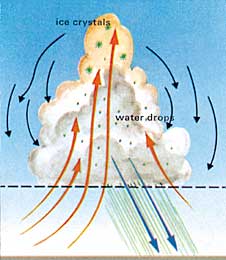 |
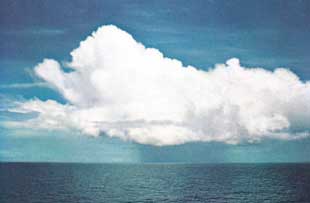 |
Figure 21: A cumulonimbus cloud. (A Colour Guide to Clouds, Scorer and Wexler, p. 23.) |
God has said in the Quran:
Meteorologists have only recently come to know these details of cloud formation, structure, and function by using advanced equipment like planes, satellites, computers, balloons, and other equipment, to study wind and its direction, to measure humidity and its variations, and to determine the levels and variations of atmospheric pressure.4
The preceding verse, after mentioning clouds and rain, speaks about hail and lightning:
Meteorologists have found that these cumulonimbus clouds, that shower hail, reach a height of 25,000 to 30,000 ft (4.7 to 5.7 miles),5 like mountains, as the Quran said,“...And He sends down hail from mountains (clouds) in the sky...” (see figure 21 above).
This verse may raise a question. Why does the verse say “its lightning” in a reference to the hail? Does this mean that hail is the major factor in producing lightning? Let us see what the book entitled Meteorology Today says about this. It says that a cloud becomes electrified as hail falls through a region in the cloud of supercooled droplets and ice crystals. 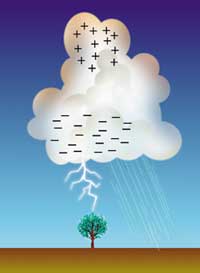 As liquid droplets collide with a hailstone, they freeze on contact and release latent heat. This keeps the surface of the hailstone warmer than that of the surrounding ice crystals. When the hailstone comes in contact with an ice crystal, an important phenomenon occurs: electrons flow from the colder object toward the warmer object. Hence, the hailstone becomes negatively charged. The same effect occurs when supercooled droplets come in contact with a hailstone and tiny splinters of positively charged ice break off. These lighter positively charged particles are then carried to the upper part of the cloud by updrafts. The hail, left with a negative charge, falls towards the bottom of the cloud, thus the lower part of the cloud becomes negatively charged. These negative charges are then discharged as lightning.6 We conclude from this that hail is the major factor in producing lightning.
As liquid droplets collide with a hailstone, they freeze on contact and release latent heat. This keeps the surface of the hailstone warmer than that of the surrounding ice crystals. When the hailstone comes in contact with an ice crystal, an important phenomenon occurs: electrons flow from the colder object toward the warmer object. Hence, the hailstone becomes negatively charged. The same effect occurs when supercooled droplets come in contact with a hailstone and tiny splinters of positively charged ice break off. These lighter positively charged particles are then carried to the upper part of the cloud by updrafts. The hail, left with a negative charge, falls towards the bottom of the cloud, thus the lower part of the cloud becomes negatively charged. These negative charges are then discharged as lightning.6 We conclude from this that hail is the major factor in producing lightning.
 As liquid droplets collide with a hailstone, they freeze on contact and release latent heat. This keeps the surface of the hailstone warmer than that of the surrounding ice crystals. When the hailstone comes in contact with an ice crystal, an important phenomenon occurs: electrons flow from the colder object toward the warmer object. Hence, the hailstone becomes negatively charged. The same effect occurs when supercooled droplets come in contact with a hailstone and tiny splinters of positively charged ice break off. These lighter positively charged particles are then carried to the upper part of the cloud by updrafts. The hail, left with a negative charge, falls towards the bottom of the cloud, thus the lower part of the cloud becomes negatively charged. These negative charges are then discharged as lightning.6 We conclude from this that hail is the major factor in producing lightning.
As liquid droplets collide with a hailstone, they freeze on contact and release latent heat. This keeps the surface of the hailstone warmer than that of the surrounding ice crystals. When the hailstone comes in contact with an ice crystal, an important phenomenon occurs: electrons flow from the colder object toward the warmer object. Hence, the hailstone becomes negatively charged. The same effect occurs when supercooled droplets come in contact with a hailstone and tiny splinters of positively charged ice break off. These lighter positively charged particles are then carried to the upper part of the cloud by updrafts. The hail, left with a negative charge, falls towards the bottom of the cloud, thus the lower part of the cloud becomes negatively charged. These negative charges are then discharged as lightning.6 We conclude from this that hail is the major factor in producing lightning.This information on lightning was discovered recently. Until 1600 AD, Aristotle’s ideas on meteorology were dominant. For example, he said that the atmosphere contains two kinds of exhalation, moist and dry. He also said that thunder is the sound of the collision of the dry exhalation with the neighboring clouds, and lightning is the inflaming and burning of the dry exhalation with a thin and faint fire.7 These are some of the ideas on meteorology that were dominant at the time of the Quran’s revelation, fourteen centuries ago.
The Quran on Deep Seas and Internal Waves
God has said in the Quran: |
This verse mentions the darkness found in deep seas and oceans, where if a man stretches out his hand, he cannot see it. The darkness in deep seas and oceans is found around a depth of 200 meters and below. At this depth, there is almost no light (see figure 15). Below a depth of 1000 meters there is no light at all.1 Human beings are not able to dive more than forty meters without the aid of submarines or special equipment. Human beings cannot survive unaided in the deep dark part of the oceans, such as at a depth of 200 meters.
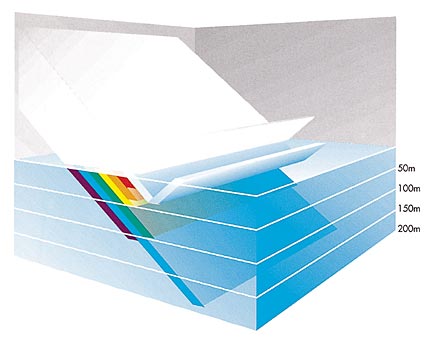 |
Figure 15: Between 3 and 30 percent of the sunlight is reflected at the sea surface. Then almost all of the seven colors of the light spectrum are absorbed one after another in the first 200 meters, except the blue light. (Oceans, Elder and Pernetta, p. 27.) |
Scientists have recently discovered this darkness by means of special equipment and submarines that have enabled them to dive into the depths of the oceans.
We can also understand from the following sentences in the previous verse, “...in a deep sea. It is covered by waves, above which are waves, above which are clouds....”, that the deep waters of seas and oceans are covered by waves, and above these waves are other waves. It is clear that the second set of waves are the surface waves that we see, because the verse mentions that above the second waves there are clouds. But what about the first waves? Scientists have recently discovered that there are internal waves which “occur on density interfaces between layers of different densities.”2 (see figure 16).
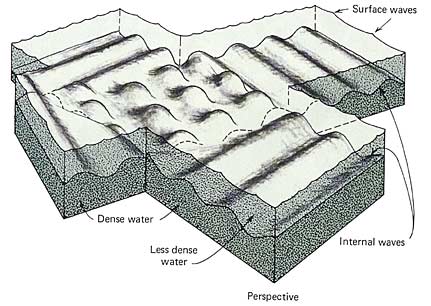 |
Figure 16: Internal waves at interface between two layers of water of different densities. One is dense (the lower one), the other one is less dense (the upper one). (Oceanography, Gross, p. 204.) |
The internal waves cover the deep waters of seas and oceans because the deep waters have a higher density than the waters above them. Internal waves act like surface waves. They can also break, just like surface waves. Internal waves cannot be seen by the human eye, but they can be detected by studying temperature or salinity changes at a given location.
The Quran on Seas and Rivers
Modern Science has discovered that in the places where two different seas meet, there is a barrier between them. This barrier divides the two seas so that each sea has its own temperature, salinity, and density.1 For example, Mediterranean sea water is warm, saline, and less dense, compared to Atlantic ocean water. When Mediterranean sea water enters the Atlantic over the Gibraltar sill, it moves several hundred kilometers into the Atlantic at a depth of about 1000 meters with its own warm, saline, and less dense characteristics. The Mediterranean water stabilizes at this depth2 (see figure 13). |
Figure 13: The Mediterranean sea water as it enters the Atlantic over the Gibraltar sill with its own warm, saline, and less dense characteristics, because of the barrier that distinguishes between them. Temperatures are in degrees Celsius (C°). (Marine Geology, Kuenen, p. 43, with a slight enhancement.) (Click on the image to enlarge it.) |
Although there are large waves, strong currents, and tides in these seas, they do not mix or transgress this barrier.
The Holy Quran mentioned that there is a barrier between two seas that meet and that they do not transgress. God has said:
But when the Quran speaks about the divider between fresh and salt water, it mentions the existence of “a forbidding partition” with the barrier. God has said in the Quran:
One may ask, why did the Quran mention the partition when speaking about the divider between fresh and salt water, but did not mention it when speaking about the divider between the two seas?
Modern science has discovered that in estuaries, where fresh (sweet) and salt water meet, the situation is somewhat different from what is found in places where two seas meet. It has been discovered that what distinguishes fresh water from salt water in estuaries is a “pycnocline zone with a marked density discontinuity separating the two layers.”3 This partition (zone of separation) has a different salinity from the fresh water and from the salt water4 (see figure 14).
Figure 14: Longitudinal section showing salinity (parts per thousand ‰) in an estuary. We can see here the partition (zone of separation) between the fresh and the salt water. (Introductory Oceanography, Thurman, p. 301, with a slight enhancement.) (Click on the image to enlarge it.) |
This information has been discovered only recently, using advanced equipment to measure temperature, salinity, density, oxygen dissolubility, etc. The human eye cannot see the difference between the two seas that meet, rather the two seas appear to us as one homogeneous sea. Likewise, the human eye cannot see the division of water in estuaries into the three kinds: fresh water, salt water, and the partition (zone of separation).
The Quran on the Cerebrum
God has said in the Quran about one of the evil unbelievers who forbade the Prophet Muhammad |
Why did the Quran describe the front of the head as being lying and sinful? Why didn’t the Quran say that the person was lying and sinful? What is the relationship between the front of the head and lying and sinfulness?
If we look into the skull at the front of the head, we will find the prefrontal area of the cerebrum (see figure 12). What does physiology tell us about the function of this area? A book entitled Essentials of Anatomy & Physiology says about this area, “The motivation and the foresight to plan and initiate movements occur in the anterior portion of the frontal lobes, the prefrontal area. This is a region of association cortex...” Also the book says, “In relation to its involvement in motivation, the prefrontal area is also thought to be the functional center for aggression....”
Figure 12: Functional regions of the left hemisphere of the cerebral cortex. The prefrontal area is located at the front of the cerebral cortex. (Essentials of Anatomy & Physiology, Seeley and others, p. 210.) (Click on the image to enlarge it.) |
So, this area of the cerebrum is responsible for planning, motivating, and initiating good and sinful behavior and is responsible for the telling of lies and the speaking of truth. Thus, it is proper to describe the front of the head as lying and sinful when someone lies or commits a sin, as the Quran has said, “...A lying, sinful naseyah (front of the head)!”
The Quran on the Origin of the Universe
The illuminating stars we see at night were, just as was the whole universe, in that ‘smoke’ material. God has said in the Quran:
Because the earth and the heavens above (the sun, the moon, stars, planets, galaxies, etc.) have been formed from this same ‘smoke,’ we conclude that the earth and the heavens were one connected entity. Then out of this homogeneous ‘smoke,’ they formed and separated from each other. God has said in the Quran:
Dr. Alfred Kroner is one of the world’s renowned geologists. He is Professor of Geology and the Chairman of the Department of Geology at the Institute of Geosciences, Johannes Gutenberg University, Mainz, Germany. He said: “Thinking where Muhammad came from . . . I think it is almost impossible that he could have known about things like the common origin of the universe, because scientists have only found out within the last few years, with very complicated and advanced technological methods, that this is the case.”  ). Also he said: “Somebody who did not know something about nuclear physics fourteen hundred years ago could not, I think, be in a position to find out from his own mind, for instance, that the earth and the heavens had the same origin.”
). Also he said: “Somebody who did not know something about nuclear physics fourteen hundred years ago could not, I think, be in a position to find out from his own mind, for instance, that the earth and the heavens had the same origin.”  ).
).
The Quran on Mountains
This is how the Quran has described mountains. God has said in the Quran:
Modern earth sciences have proven that mountains have deep roots under the surface of the ground (see figure 9) and that these roots can reach several times their elevations above the surface of the ground.2 So the most suitable word to describe mountains on the basis of this information is the word ‘peg,’ since most of a properly set peg is hidden under the surface of the ground. The history of science tells us that the theory of mountains having deep roots was introduced only in the latter half of the nineteenth century.3
Mountains also play an important role in stabilizing the crust of the earth.4 They hinder the shaking of the earth. God has said in the Quran:
Likewise, the modern theory of plate tectonics holds that mountains work as stabilizers for the earth. This knowledge about the role of mountains as stabilizers for the earth has just begun to be understood in the framework of plate tectonics since the late 1960’s.5
Could anyone during the time of the Prophet Muhammad  have known of the true shape of mountains?
have known of the true shape of mountains?  Could anyone imagine that the solid massive mountain which he sees before him actually extends deep into the earth and has a root, as scientists assert? A large number of books of geology, when discussing mountains, only describe that part which is above the surface of the earth. This is because these books were not written by specialists in geology. However, modern geology has confirmed the truth of the Quranic verses.
Could anyone imagine that the solid massive mountain which he sees before him actually extends deep into the earth and has a root, as scientists assert? A large number of books of geology, when discussing mountains, only describe that part which is above the surface of the earth. This is because these books were not written by specialists in geology. However, modern geology has confirmed the truth of the Quranic verses.
 Could anyone imagine that the solid massive mountain which he sees before him actually extends deep into the earth and has a root, as scientists assert? A large number of books of geology, when discussing mountains, only describe that part which is above the surface of the earth. This is because these books were not written by specialists in geology. However, modern geology has confirmed the truth of the Quranic verses.
Could anyone imagine that the solid massive mountain which he sees before him actually extends deep into the earth and has a root, as scientists assert? A large number of books of geology, when discussing mountains, only describe that part which is above the surface of the earth. This is because these books were not written by specialists in geology. However, modern geology has confirmed the truth of the Quranic verses.
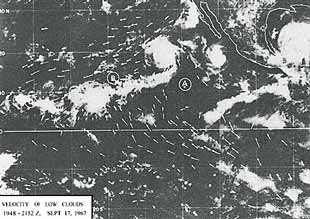
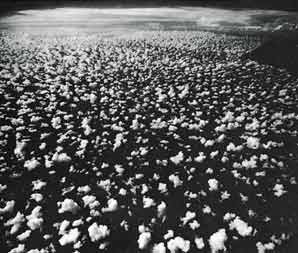
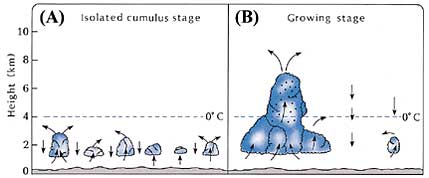
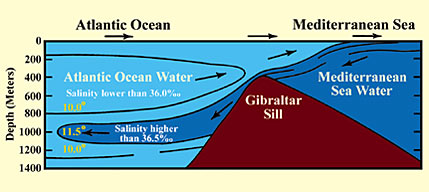
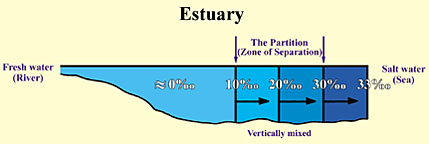
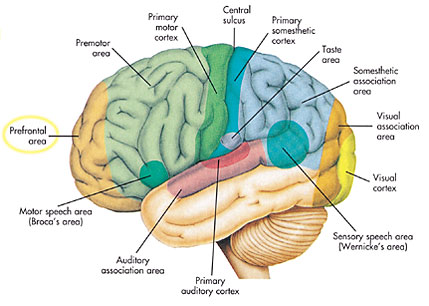
0 comments:
Post a Comment